
The Breed History
In medieval times, dogs used to hunt badger were termed
dachshund; the name means "badger hound". The wirehaired
versions were bred in order to protect the dogs from heavy brush.
The first definitive records of specific breed type can be traced
to the 17th century. By 1900, three varieties; a short, long, and
wirehaired were recognized. The first German studbook records date
to the mid 1800s. First AKC registry occurred in 1885. Standard
and Miniature types are shown in separate class divisions and bred
separately.
Breeding for Function
Though bred specifically to take on the tough badger, these
standard-sized dogs were also used in packs to hunt wild boar.
Stamina and courage were hallmarks of these hunting partners.
Smaller versions of the Dachshund were used to hunt fox, and it is
this variety that has become most popular. Miniature dachshunds
were also in the hunt for hare and rabbit quarry. The typical
companion dachshund is a medium-sized smooth coated variety.
The breed is noted for below ground work and their scent and vocal
skills are well developed.
Physical Characteristics
Height at Withers: no standard, but they are usually under 9"
(23 cm).
Weight: Miniature: less than 11 lb (5 kg) at 1 year, Standard: 16-32 lb
(7-14.5 kg).
Coat:
1. Solid (self colored): includes red, cream. Nose and nails are black
with these dogs.
2. Bi-colored: chocolate, black, Isabella (fawn) and gray (blue), with
tan markings. A small white marking is acceptable on the chest.
Dark bi-colored dogs have black noses and nails but other colors
may have self or brown nose and nail color.
3. Dapple: intermixed light and dark with neither color
predominating. In double dapples a larger white chest marking is
allowed. Single and double dapple varieties exist. In the latter, white
overlays the single dapple coloration.
4. Brindle dogs have a pattern of stripes that are black or dark over
the body or within the tan points.
Three haircoat types:
1. Longhaired: Slightly wavy, the haircoat is longer under the body
and behind the limbs. The ears particularly, should be endowed with
longer silky hair. The tail has the longest hairs of the coat, and is
structured to form a flag.
2. Smooth: The shorthaired variety possesses a very flat, glossy
short haircoat.
3. Wirehaired: Over the body a thick, rough outer coat and a soft
undercoat are interspersed. The ear, brow and jaw are free of the
wirehair.
Longevity: 12-15 years
Points of Conformation: A low slung conformation with long
back and very short limbs give this dog the appearance of being
able to fit down a narrow quarry den. High head carriage and
energetic gait provide surprisingly good agility and speed. The head
tapers and the eyes are medium sized, almond shaped and have a
very darkly pigmented iris. The palpebral margins are pigmented.
It is only in dapple coloring that wall eyes are accepted. Ears are
pendulous, rounded and of moderate length and set, and they
turn inwards towards the tips. Little stop is noted, and the nose is
preferred to be pigmented black. The neck is long, slightly arched
and muscular without evidence of dewlap. The topline is long and
the loin is only slightly arched. The breastbone is prominent, the
ribs well sprung, and a characteristic bowing of the legs typical
for chondrodystrophic breeds is present. Forelimbs are generally
abducted due to carpal deviation. Feet are small, well arched, and
possess thick pads. Dewclaws may be removed; rear dewclaws
typically are. The tail is slightly curved and carried close to level
with topline.
Recognized Behavior Issues and Traits
Reported breed characteristics include: Good in town or country,
active outdoors, a gentle companion, a good alert barker,
affectionate, and playful. Dachshunds are intelligent, easy to
maintain because of low grooming needs, and if properly socialized,
good with gentle children. They may have a strong independent,
even stubborn streak, may be aggressive with strange dogs and
aloof with strangers, and often have high barking and digging
tendencies. They will become destructive if bored. Considered an
average shedder, the coat care depends on coat type: smooth coats
need minimal brushing, wire coats need to be stripped twice per
annum, and a long hair coat needs daily grooming. They can tend to
be biters, and this should be discouraged when young.
Normal Physiologic Variations
The merle gene produces the dapple coat color in the dachshund.
Dapple dachshunds should not be bred together, as homozygous
merle (MM) tend to produce microphthalmia, blindness, deafness,
and other abnormalities.
The dilute gene produces the blue coat color in the homozygous
state (dd). This can predispose to color dilution alopecia.
In a UK study, 31.2% of Dachund litters were delivered via C-section.
Drug Sensitivities
None reported
Inherited Diseases
Patella Luxation: Polygenically inherited laxity of patellar
ligaments, causing luxation, lameness, and later degenerative joint
disease. Treat surgically if causing clinical signs. OFA reports 7.1%
affected.
Hip Dysplasia and Legg-Calve Perthes Disease: Polygenically
inherited traits causing degenerative hip joint disease and arthritis.
OFA reports 8.1% affected. Reported 4.8x odds ratio for Legg-Calve-
Perthes versus other breeds.
Progressive Retinal Atrophy (PRA)/Cone-Rod Dystrophy
(cord1): Hereditary disorder of retinal degeneration. There are
two populations of affected miniature longhaired dachshunds,
with one group presenting with night blindness that progresses to
total blindness at 4 months to 2 years of age, and another group
presenting between 2 years and 15 years of age. Identified in 1.66%
of longhaired miniature, 1.30% of longhaired standard, and 1.19%
of smooth miniature dachshunds CERF examined by veterinary
ophthalmologists between 2000-2005. An autosomal recessive
mutation in the RPGRIP1 gene is highly correlated to early age
clinical PRA, and slightly less so to the later age presentation. 16%
of miniature longhaired dachshunds homozygous for the mutation
retain normal sight, and some affected dogs do not carry the
RPGRIP1 mutation, demonstrating a more complex etiology for this
disease. A second locus had been identified that may modify age of
onset of the disorder. A genetic test for the RPGRIP1 mutation is
available.
Progressive Retinal Atrophy (PRA)/Cone-Rod Dystrophy (NPHP4):
A mutation in the NPHP4 gene is responsible for this autosomal
recessive form of cone-rod dysplasia in standard wire-haired
Dachshunds. Affected dogs have cone and rod degeneration by
5 weeks of age, and present with pin-point sized pupils. 9.6% of
standard wire-haired Dachshunds test carrier in Norway.
Elbow Dysplasia: Polygenically inherited trait causing elbow
arthritis. Too few Dachshunds have been screened by OFA to
determine an accurate frequency.
Neuronal Ceroid-Lipofuscinosis (NCL): Dachshunds have two
different fatal forms of NCL, that present with ataxia, behavior
changes, and seizures. An adult-onset (4.5-6.5 years) form presents
between 4.5-6.5 years of age, and a juvenile-onset form presents at
9 months of age. The juvenile-onset form is an autosomal recessive
disorder caused by a mutation in the PPT1 gene, and a genetic test
is available.
Mucopolysaccharidosis IIIA (MPS IIIA or Sanfilippo A): Autosomal
recessive storage disease. Pelvic limb ataxia begins around 3 years
of age, progresses gradually within 1-2 y to severe generalized
spinocerebellar ataxia. A genetic test is available.
Progressive Myoclonic Epilepsy (PME): A fatal autosomal
recessive disorder identified in miniature wirehaired dachshunds,
causing progressive myoclonic twitching and seizures. The genetic
mutation has been identified.
Pyruvate Kinase Deficiency (PK): Autosomal recessive disorder
causing severe hemolytic anemia, progressive osteomyelosclerosis,
and hemosiderosis. Death occurs due to anemia or hepatic failure
usually at less than five years of age. Occurs at a low frequency in
the breed. A genetic test is available.
Narcolepsy: Rare, autosomal recessive disorder causing sudden
collapse and a sleep-like state elicited by excitement. Identified in a
family of dachshunds, and in other sporadic cases. A genetic test is
available.
Osteogenesis Imperfecta: Rare, autosomal recessive disease seen
in rough-coated juvenile dachshunds. Affected dogs present with
pain, spontaneous bone and teeth fractures, joint hyperlaxity, and
reduced bone density on radiography. Caused by a mutation in the
SERPINH1 gene causing defective collagen synthesis.
Disease Predispositions
Intervertebral Disc Disease (IVDD): Spinal cord disease due to
prolapsed disk material. Clinical signs include back pain, scuffing
of paws, spinal ataxia, limb weakness, and paralysis. Studies
have shown that 76% of all dachshunds have radiographically
identifiable calcified disk material by 24 months of age. Almost
all dogs with IVDD have calcified disk material. Dachshunds
with calcified disks had a higher rate of recurrence of IVDD. In
a Japanese study, Dachshunds represented 53.3% of dogs with
thoracolumbar IVDD at an average age of 5.6 years, and 12.9% of
dogs with cervical IVDD at an average age of 7.8 years. Occurs at a
frequency of 15.6% in the breed. Dorn reports an 57.01x odds ratio
versus other breeds.
Persistent Pupillary Membranes: Strands of fetal remnant
connecting; iris to iris, cornea, lens, or involving sheets of tissue.
The later three forms can impair vision, and dogs affected with
these forms should not be bred. Identified in 11.63% of wirehaired
miniature, 10.41% of wirehaired standard, 6.22% of longhaired
miniature, 4.71% of smooth standard, 3.57% of standard miniature,
and 3.03% of longhaired standard Dachshunds CERF-examined by
veterinary ophthalmologists between 2000-2005.
Iris Coloboma: A coloboma is a congenital defect which may affect
the iris, choroid or optic disc, which may affect vision. Identified
in 9.30% of wirehaired miniature, and 4.76% of smooth miniature
Dachshunds CERF-examined by veterinary ophthalmologists between
2000-2005. CERF does not recommend breeding affected dogs.
Distichiasis: Abnormally placed eyelashes that irritate the cornea
and conjunctiva. Can cause secondary corneal ulceration. Identified
in 9.13% of longhaired miniature, 6.93% of longhaired standard,
2.33% of wirehaired miniature and standard, and 1.74% of smooth
standard Dachshunds CERF-examined by veterinary ophthalmologists
between 2000-2005.
Corneal Dystrophy: Dachshunds can have an epithelial/stromal
form of corneal dystrophy. Identified in 4.65% of wirehaired
miniature and standard Dachshunds CERF-examined by veterinary
ophthalmologists between 2000-2005.
Cataracts: Anterior, posterior, intermediate and punctate
cataracts occur in the breed. In a German study of boar-colored
wirehaired Dachshunds, primary cataracts were present in 3.83%,
and prominent suture lines in 2.76%. Heritabilities ranged from
0.36-0.39, with different forms of cataract positively correlated
to each other. Identified in 3.32% of longhaired miniature,
3.23% of smooth standard, 2.60% of wirehaired standard, 2.38%
of longhaired standard, and 2.33% of wirehaired miniature
Dachshunds CERF-examined by veterinary ophthalmologists
between 2000-2005. CERF does not recommend breeding any
Dachshund with a cataract.
Persistent Hyaloid Artery (PHA): Congenital defect resulting
from abnormalities in the development and regression of the
hyaloid artery. Identified in 3.35% of wirehaired standard, 1.24% of
longhaired miniature, and 1.19% of smooth miniature Dachshunds
CERF-examined by veterinary ophthalmologists between
2000-2005.
Hypothyroidism: Inherited autoimmune thyroiditis. 2.8% positive
for thyroid auto-antibodies based on testing at Michigan State
University. (Ave. for all breeds is 7.5%.)
Hyperadrenocorticism (Cushing's Disease): Hyperfunction of the
adrenal gland caused by a pituitary or adrenal tumor. Clinical signs
may include increased thirst and urination, symmetrical truncal
alopecia, and abdominal distention. Dorn reports an 1.80x odds
ratio versus other breeds. One study found a high incidence in a
family of wire-haired Dachshunds.
Mitral Valve Disease/Prolapse: Dachshunds are a breed
at increased risk of developing mitral regurgitation due to
myxomatous changes, and later mitral valve prolapse. Diagnosis by
echocardiography. Breeding studies suggest a polygenic mode of
inheritance.
Chronic Superficial Keratitis/Pannus: A bilateral disease of the
cornea which usually starts as a grayish haze to the ventral or
ventrolateral cornea, followed by the formation of a vascularized
subepithelial growth that begins to spread toward the central
cornea; pigmentation follows the vascularization. CERF does not
recommend breeding any affected dogs.
Punctate Keratitis: Focal circular rings usually affecting the central
subepithelial and/or anterior portion of the cornea. There often is an
associated dry eye with corneal erosions. The mode of inheritance is
unknown. CERF does not recommend breeding any affected dogs.
Optic Nerve Coloboma: A congenital cavity in the optic nerve
which, if large, may cause blindness or vision impairment. Identified
in 2.38% of smooth miniature Dachshunds CERF examined by
veterinary ophthalmologists between 2000-2005. CERF does not
recommend breeding affected dogs.
Microphthalmia: A congenital defect characterized by small globes
of the eye. Often associated with merle. Identified in 2.38% of
smooth miniature, 2.33% of wirehaired miniature, and 1.66% of
longhaired miniature Dachshunds CERF examined by veterinary
ophthalmologists between 2000-2005. CERF does not recommend
breeding affected dogs.
Retinal Dysplasia: Focal retinal dysplasia and retinal folds are
recognized in the breed. Identified in 2.33% of wirehaired miniature,
1.49% of wirehaired and smooth standard, and 1.08% of longhaired
standard Dachshunds CERF examined by veterinary ophthalmologists
between 2000-2005.
Color-dilution Alopecia: Condition seen in some blue (dilute)
colored Dachshunds. Starts as a gradual onset of dry, dull and
poor hair coat quality. Progresses to poor hair regrowth, follicular
papules and comedomes. Hair loss and comedome formation
are usually most severe on the trunk. Dorn reports an 4.56x odds
ratio for developing alopecia versus other breeds. A genetic test is
available for the dilute gene.
Optic Nerve Hypoplasia: Congenital malformation of the optic
nerve causing blindness. Identified in 1.24% of smooth standard
and 1.19% of smooth miniature Dachshunds CERF examined by
veterinary ophthalmologists between 2000-2005. CERF does not
recommend breeding any Dachshund with the condition.
Urolithiasis; Xanthine, Cystine: Dachshunds are found to be a
breed at increased risk of forming bladder stones. Several cases
of xanthine urinary stones have been diagnosed in the breed,
suggesting an inherited disorder of xanthine oxidase. The breed also
has an increased incidence of Cystinuria and cystine stones versus
other breeds.
Deafness: Dappled dachshunds can have congenital deafness due
to the merle gene. Can be unilateral or bilateral. Diagnosed by BAER
testing. In a multi-breed study; for single merles (Mm), 2.7% were
unilaterally deaf and 0.9% were bilaterally deaf. For double merles
(MM), 10% were unilaterally deaf and 15% were bilaterally deaf.
Cutaneous Histiocytoma: Benign dermal tumor that usually
presents as a single, hairless "button-like" mass in dogs under 3
years of age. The tumor spontaneously regresses over 3 months.
Seen at an increased frequency in the breed.
Sudden Acute Retinal Degeneration (SARDS): Degenerative
retinal disease causing acute blindness. Age of onset from 1.5 to
15 years, with an average of 8.4 years. In one study, 9% of affected
dogs were Dachshunds. Diagnose with ERG.
Congenital Myasthenia Gravis: Disorder of exercise induced
muscle weakness identified in immature miniature dachshunds.
Clinical signs resolve spontaneously by 6 months of age.
Nasopharyngeal Dysgenesis/stenosis: Congenital disorder
characterized by expiratory cheek puffing, upper respiratory
dyspnea, macroglossia, and dysphagia. Treatment is with surgery.
Unknown mode of inheritance.
Sterile Panniculitis: Rare, dermatological disease of subcutaneous
fat inflammation characterized by deep cutaneous nodules that
often ulcerate and drain pus or oil. Treat with immunosuppressive
medications. Miniature Dachshunds represent 51.2% of all cases.
Unknown mode of inheritance.
Acanthosis Nigricans, Brachygnathism, Bullous Pemphigoid,
Calcinosis Circumscripta, Cleft Lip/Palate, Cryptorchidism,
Cutaneous Asthenia, Demodicosis, Dermoid, Entropion, Glaucoma, Heterochromia Iridis, Juvenile Cellulitis,
Keratoconjunctivitis Sicca, Micropapilla, Portosystemic
Shunting, Seasonal Flank Alopecia, Sebaceous Adenitis, Sensory
Neuropathy, Vasculitis, and von Willebrand's Disease are
reported.
Isolated Case Studies
Immunodeficiency and Pneumonocystis Carinii Pneumonia:
Seven cases of Dachshunds under one year of age were diagnosed
with P. Carinii pneumonia; all had both T-cell and B-cell deficiency.
Affected dogs presented with polypnea, tachypnea, and exercise
intolerance.
Uveodermatologic (VKH-like) Syndrome: Identified in a female
Dachshund. Autoimmune disease manifested by progressive uveitis
and depigmenting dermatitis that closely resembles the human
Vogt-Koyanagi-Harada syndrome. Treat with immunosuppressive
drugs. CERF does not recommend breeding any affected dogs.
Genetic Tests
Tests of Genotype: Direct test for PRA/cord1 is available from the
University of Missouri and the Animal Health Trust.
Direct test for juvenile Ceroid lipofuscinosis is available from the
University of Missouri.
Direct tests for pyruvate kinase deficiency and MPS are available
from PennGenn.
Direct test for narcolepsy is available from Optigen.
Direct tests for "true red", black or black and tan or red with dark
tips and chocolate or chocolate & tan coat colors, and black or
brown nose are available from HealthGene and VetGen.
Direct test for coat length is available from DDC Veterinary and
VetGen.
Tests of Phenotype: CHIC Certification: Required testing
includes CERF eye examination and patella evaluation. Optional
recommended tests are Direct test for PRA/Cord1, thyroid profile
including autoantibodies, and BAER test for deafness. (See CHIC
website; caninehealthinfo.org).
Additional Recommended test: hip and elbow radiographs, and
cardiac evaluation.
Miscellaneous
- Breed name synonyms: Teckel, Zwergteckel, Normalgrosse
Teckel.
- Registries: AKC, UKC, CKC, KCGB (Kennel Club of Great Britain),
ANKC (Australian National Kennel Club), NKC (National Kennel Club).
- AKC rank (year 2008): 7 (26,075 registered)
- Internet resources: Dachshund Club of America:
dachshund-dca.org
National Miniature Dachshund Club, Inc.:
dachshund-nmdc.org
The Dachshund Club (UK): dachshundclub.co.uk
Photo Gallery of Breed - Dachshund - Dog Breed


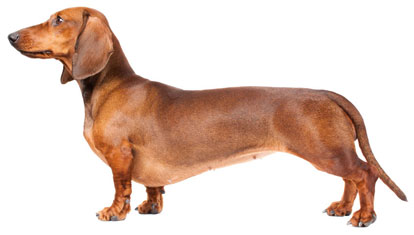
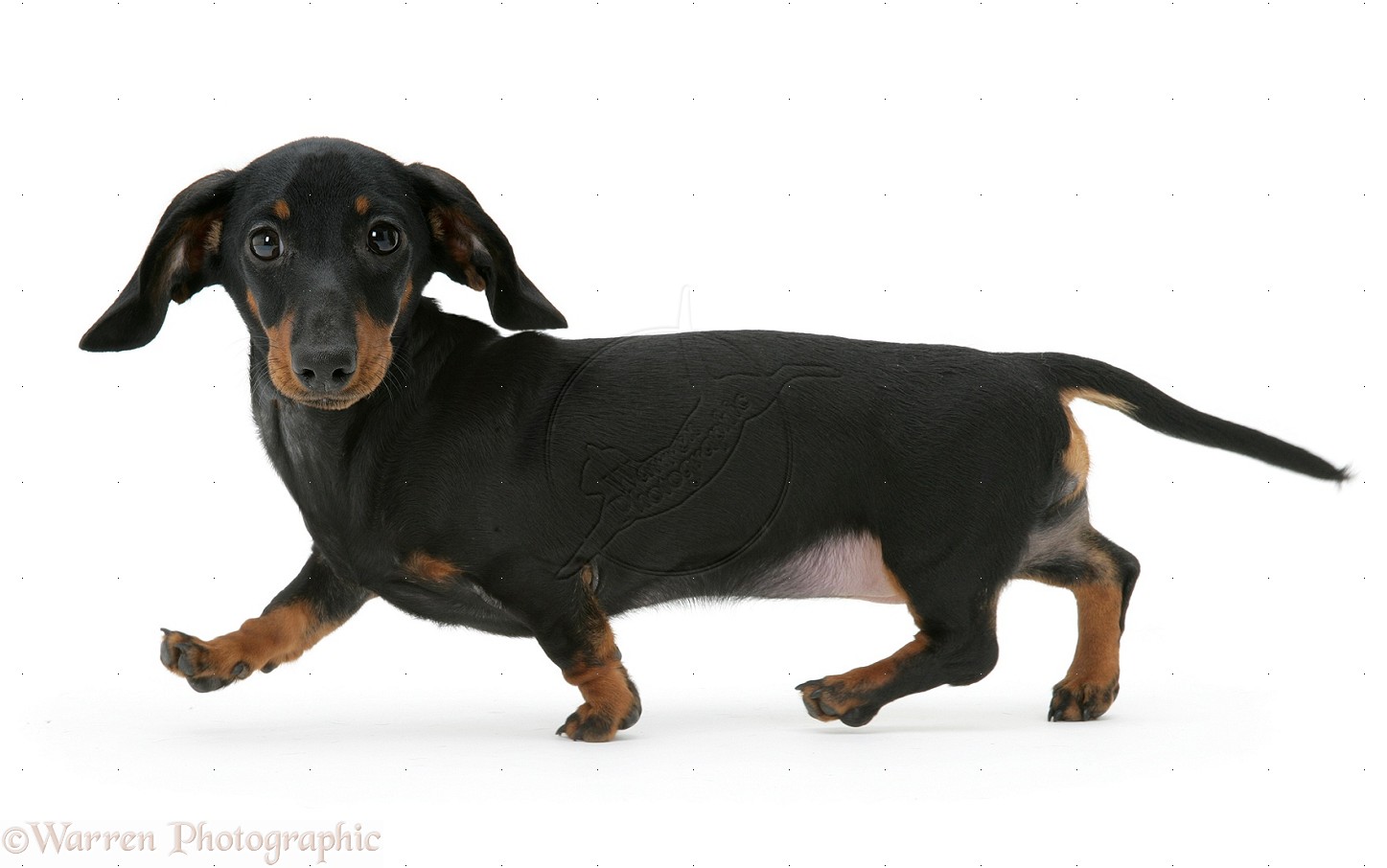
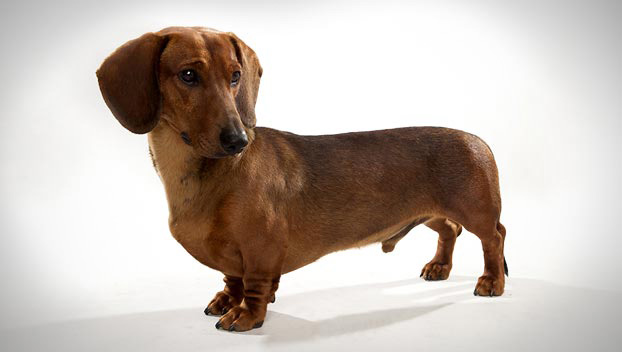
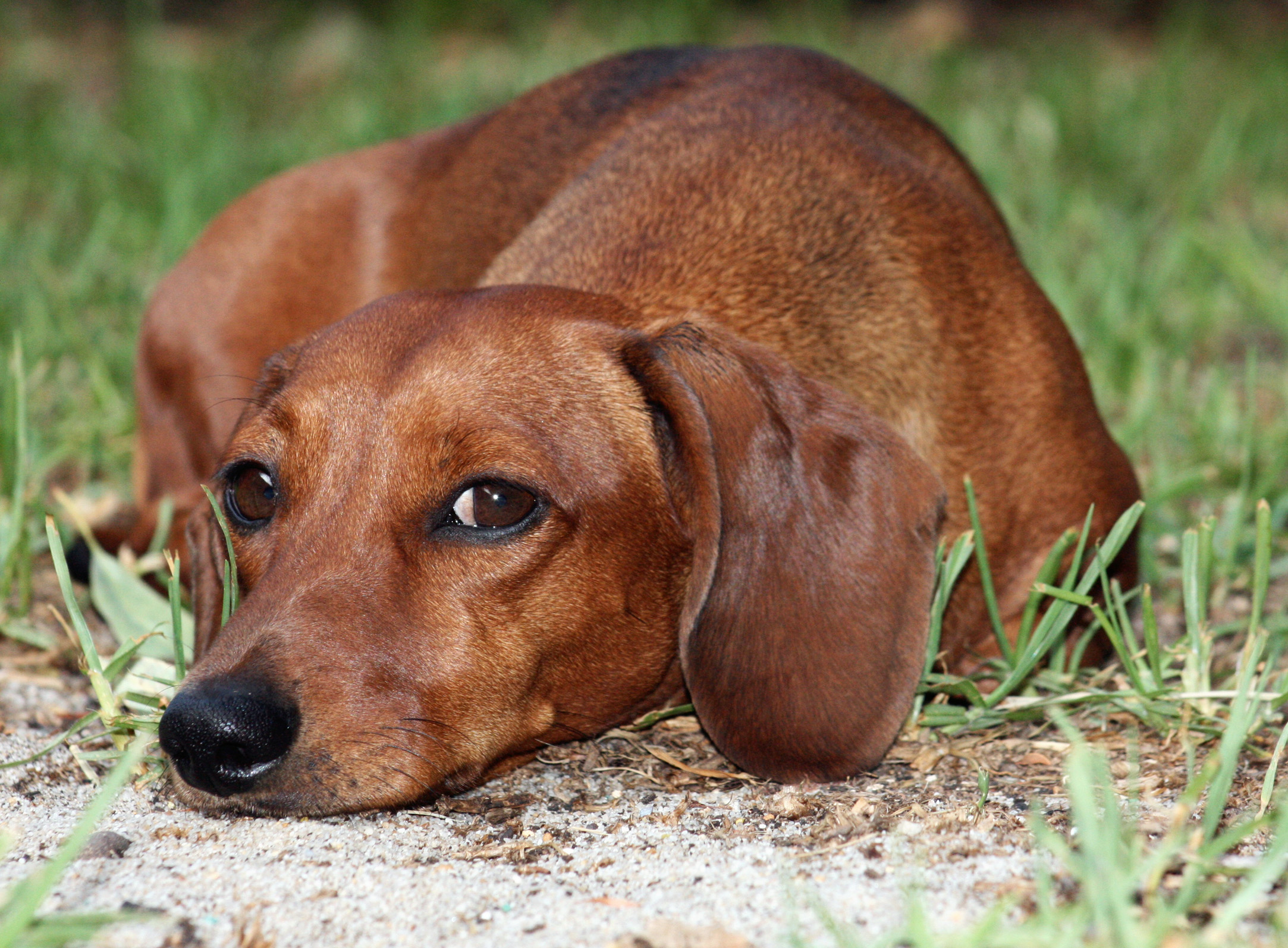

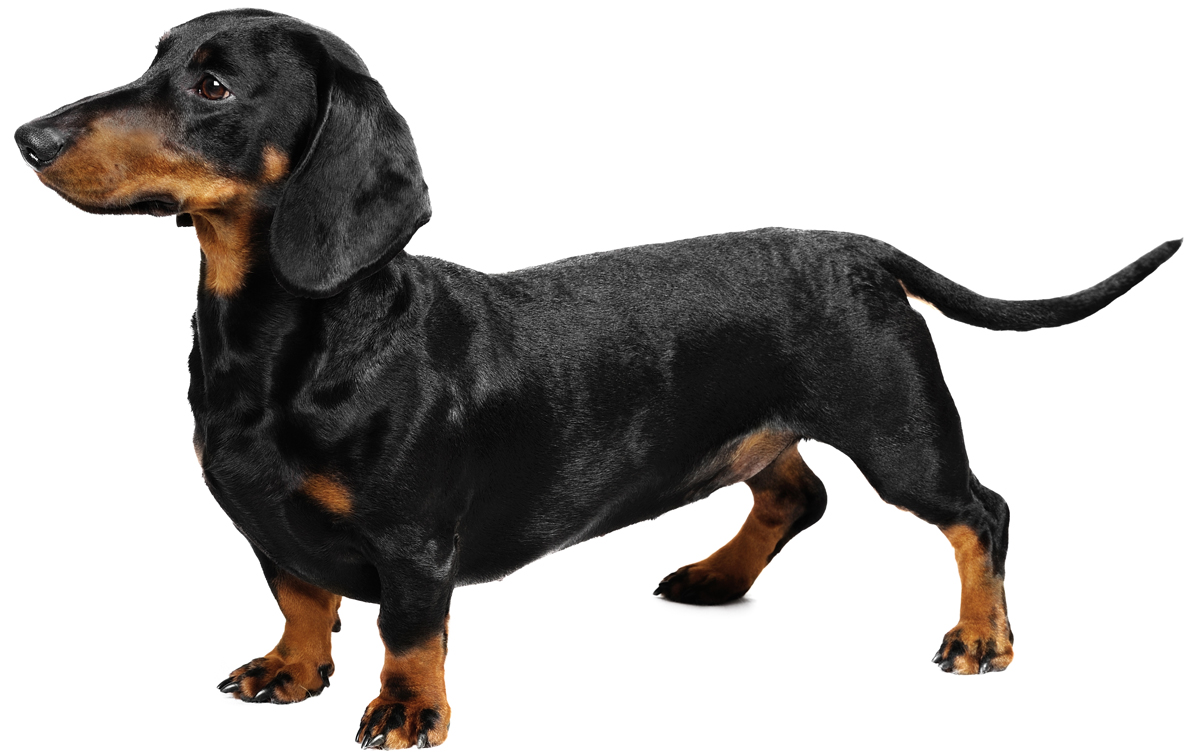
 Animalia Life
Animalia Life